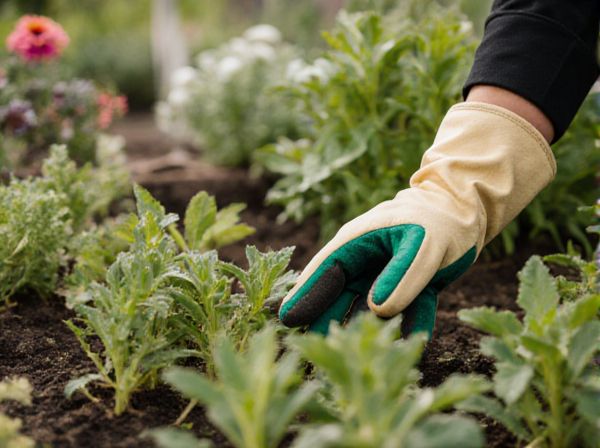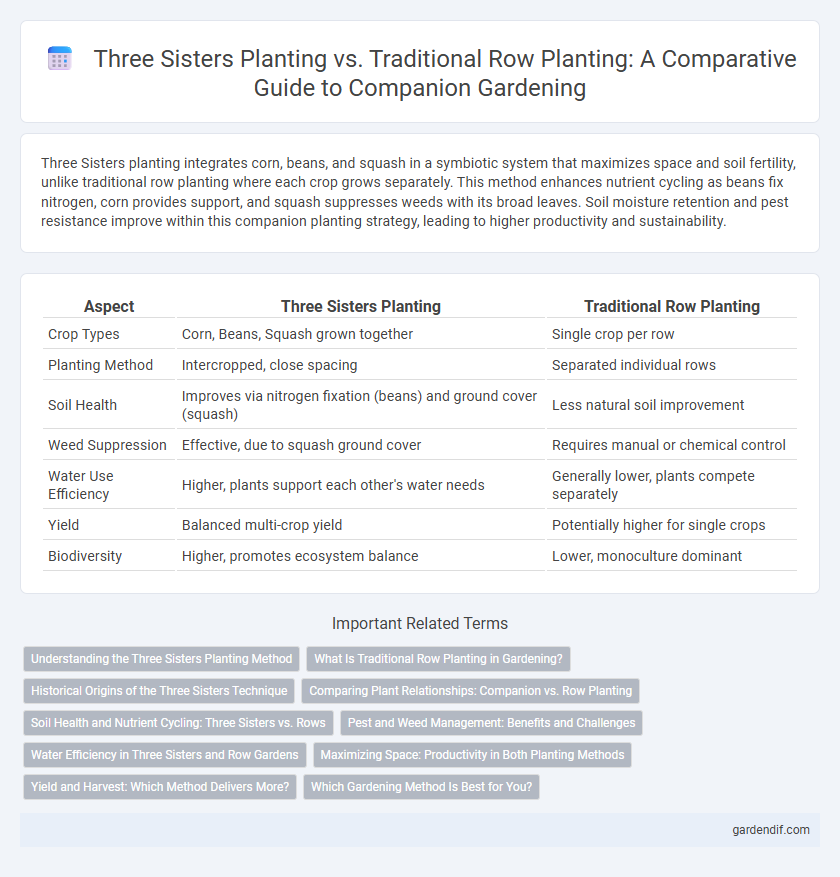
Three Sisters vs traditional row planting Illustration
Three Sisters planting integrates corn, beans, and squash in a symbiotic system that maximizes space and soil fertility, unlike traditional row planting where each crop grows separately. This method enhances nutrient cycling as beans fix nitrogen, corn provides support, and squash suppresses weeds with its broad leaves. Soil moisture retention and pest resistance improve within this companion planting strategy, leading to higher productivity and sustainability.
Table of Comparison
| Aspect | Three Sisters Planting | Traditional Row Planting |
|---|---|---|
| Crop Types | Corn, Beans, Squash grown together | Single crop per row |
| Planting Method | Intercropped, close spacing | Separated individual rows |
| Soil Health | Improves via nitrogen fixation (beans) and ground cover (squash) | Less natural soil improvement |
| Weed Suppression | Effective, due to squash ground cover | Requires manual or chemical control |
| Water Use Efficiency | Higher, plants support each other's water needs | Generally lower, plants compete separately |
| Yield | Balanced multi-crop yield | Potentially higher for single crops |
| Biodiversity | Higher, promotes ecosystem balance | Lower, monoculture dominant |
Understanding the Three Sisters Planting Method
The Three Sisters planting method combines corn, beans, and squash in a symbiotic polyculture, enhancing soil fertility and maximizing space efficiency compared to traditional row planting. Corn provides a natural trellis for the beans, which fix nitrogen in the soil, while squash spreads along the ground, suppressing weeds and retaining moisture. This integrated approach promotes biodiversity, reduces the need for synthetic fertilizers, and increases overall crop yield through mutual plant benefits.
What Is Traditional Row Planting in Gardening?
Traditional row planting in gardening involves sowing seeds or transplanting seedlings in straight, evenly spaced rows, allowing for easy access, watering, and maintenance. This method maximizes efficient use of space and simplifies pest control and weed management through mechanical cultivation or hand weeding. Commonly used for crops like corn, beans, and tomatoes, traditional row planting contrasts with more integrated companion planting systems like the Three Sisters.
Historical Origins of the Three Sisters Technique
The Three Sisters planting technique, rooted in Indigenous agricultural practices of Native American tribes such as the Haudenosaunee, integrates corn, beans, and squash to optimize space and soil nutrients. This method contrasts with traditional row planting by promoting symbiotic growth where corn provides structure for beans to climb, beans fix nitrogen to enrich the soil, and squash suppresses weeds with its broad leaves. Historical origins trace back over a thousand years, illustrating a sustainable approach to agriculture that supports biodiversity and soil health.
Comparing Plant Relationships: Companion vs. Row Planting
Three Sisters planting fosters symbiotic relationships by combining corn, beans, and squash in a mutually beneficial arrangement where beans fix nitrogen, corn provides a climbing structure, and squash suppresses weeds with its sprawling leaves. Traditional row planting separates crops, often limiting natural interdependence and nutrient sharing, which can increase the need for external fertilizers and pest control. Companion planting enhances biodiversity and soil health, promoting sustainable growth that contrasts with the monoculture tendencies in row planting systems.
Soil Health and Nutrient Cycling: Three Sisters vs. Rows
The Three Sisters planting method enhances soil health by combining corn, beans, and squash, which naturally enrich the soil through nitrogen fixation by beans and ground coverage by squash to reduce erosion. In contrast, traditional row planting often relies on synthetic fertilizers and leaves soil more exposed, resulting in slower nutrient cycling and increased soil degradation. This integrated polyculture improves microbial activity and nutrient retention, promoting sustainable soil fertility compared to conventional monoculture rows.
Pest and Weed Management: Benefits and Challenges
Three Sisters planting creates a diverse ecosystem that naturally reduces pest populations by attracting beneficial insects and disrupting pest habitats, offering more effective pest management compared to traditional row planting. The dense cover crops in Three Sisters also suppress weeds by limiting sunlight penetration and minimizing bare soil exposure, reducing the need for herbicides. However, the complexity of multiple crops grown together can make targeted pest control and weed management more challenging due to varied plant requirements and overlapping growth stages.
Water Efficiency in Three Sisters and Row Gardens
Three Sisters planting significantly improves water efficiency compared to traditional row gardens by promoting deeper soil moisture retention through its symbiotic crop arrangement of corn, beans, and squash. The dense canopy created by squash leaves reduces soil evaporation while the climbing beans provide natural nitrogen fixation, enhancing soil health without excessive irrigation. Studies show that Three Sisters gardens can reduce water usage by up to 30% while maintaining higher yields than conventional row planting methods.
Maximizing Space: Productivity in Both Planting Methods
Three Sisters planting leverages vertical and horizontal space by intertwining corn, beans, and squash, optimizing sunlight exposure and nutrient use, which boosts overall yield per square foot compared to traditional row planting. Traditional row planting prioritizes ease of access and mechanization but often underutilizes vertical space, leading to lower productivity density. Integrating supportive plant relationships in Three Sisters enhances sustainable soil health and maximizes space efficiency for higher productivity.
Yield and Harvest: Which Method Delivers More?
Three Sisters planting, combining corn, beans, and squash, often yields higher overall productivity by maximizing space and promoting complementary growth, resulting in more diverse and abundant harvests compared to traditional row planting. Row planting typically produces higher single-crop yields due to optimized spacing and mechanization but lacks the polyculture benefits that improve soil health and pest resistance in Three Sisters gardens. Studies highlight that Three Sisters gardens deliver greater cumulative yield per area, especially in small-scale or sustainable farming contexts where biodiversity and resource efficiency are prioritized.
Which Gardening Method Is Best for You?
Three Sisters planting combines corn, beans, and squash to create a symbiotic relationship that maximizes space, improves soil health, and reduces pests, making it ideal for gardeners seeking sustainability and ecological balance. Traditional row planting separates crops, simplifying maintenance and irrigation, which works well for those who prefer straightforward planting and harvesting processes. Choosing the best method depends on your garden size, desired yield, and commitment to natural pest control versus ease of management.
Three Sisters vs traditional row planting Infographic

 gardendif.com
gardendif.com